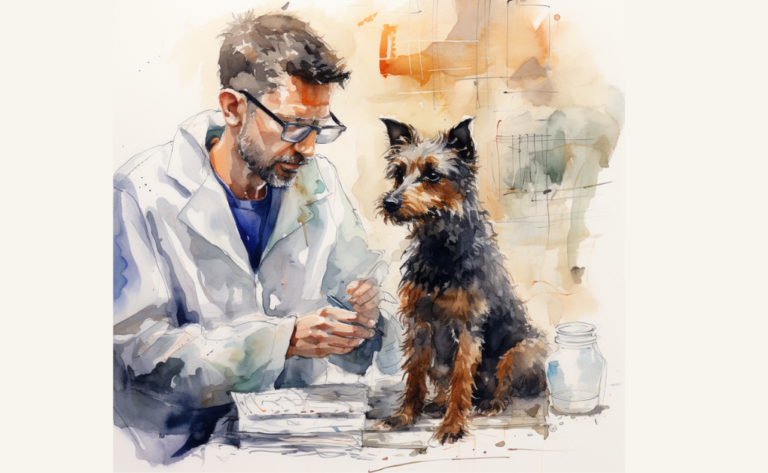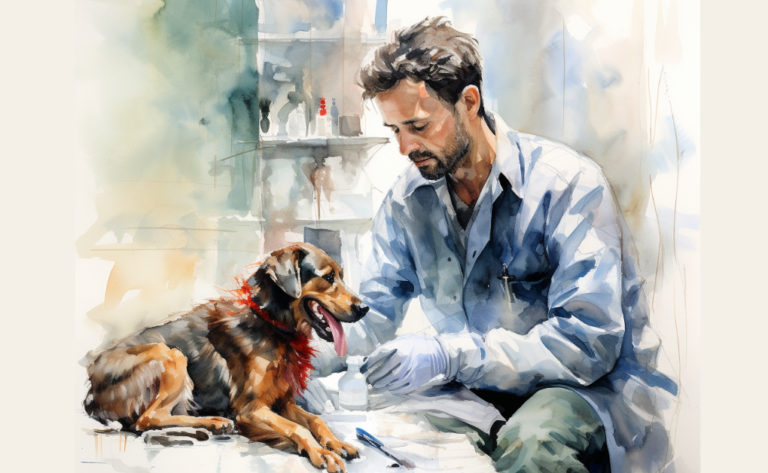What is Ear Infection in Dogs?
What is it?
How is it Treated?
Breed Predispositions
Cocker Spaniels Basset Hounds Beagles Labrador Retrievers Golden Retrievers Poodles Shar Peis Bulldogs
Introduction
For weeks, Emily had noticed her sweet Cocker Spaniel, Daisy, shaking her head and rubbing her ears on the carpet. She thought it was just a quirky habit, but when Daisy started to become more irritable and lethargic, Emily knew something was wrong. Deciding to consult her veterinarian, she scheduled an appointment and brought Daisy in for a thorough examination. The vet’s diagnosis was an ear infection, which came as a surprise to Emily, who had no idea her beloved dog could suffer from such a condition.
Ear infections, an issue affecting puppies and adult dogs of various breeds, are widespread health concerns. The invasion of bacteria, yeast, or other microorganisms into the ear canal often prompts inflammation or infection, termed inflammation of the ear canal. If these conditions are overlooked, they can cause significant discomfort and potentially permanent ear damage.
Ear infections are surprisingly common, with approximately 20% of dogs experiencing some form of ear disease in their lifetime. Notably, certain breeds like the Basset Hound, known for the distinctive shape of their ear, may be more susceptible.
It’s worth noting that ear infections can take several forms and affect different ear parts. In some instances, the issue remains confined to the outer ear. However, in other cases, it progresses into the middle ear. When an ear canal becomes infected, it could become blocked, accumulating fluid inside the ear, creating further complications.
Types of Dog Ear Infections
There are three types of ear infections in dogs.
Otitis Externa
This is often called external otitis because it occurs outside the eardrum. This type of infection most commonly affects dogs older than one year old. Otitis externa usually begins with itching around the ears, followed by discharge. If left untreated, the dog might develop pain, swelling, redness, and crusting inside the ear.
Otitis Media
This is often referred to as middle ear disease or infection because it occurs in the central ear area. Viruses typically cause otitis media. Symptoms include fever, lethargy, loss of appetite, vomiting, and diarrhea. A veterinarian might recommend antibiotics to treat this type of infection.
Otitis Interna
This is usually called an inner ear infection because it occurs inside the inner ear. Bacterial infections typically cause ear infections. Symptoms include excessive drooling, head tilt, circling, weakness, and seizures. In addition, an owner might notice that their dog seems disoriented, confused, or unable to stand up straight.
What are the Causes of Ear Infections in Dogs?
The causes of ear infections differ from dog to dog, potentially impacting one or both ears. Approximately 20% of canines contract some form of ear disease. However, several prevalent factors can instigate ear infections:

- Bacterial or Yeast Overgrowth: A dog’s ear naturally houses bacteria and yeast. However, any imbalance in the ear’s environment due to moisture, allergies, trapped debris, or weakened immune function could instigate an overgrowth. This overgrowth can result in a bacterial infection, disrupting the usual harmony in the ear and promoting infection.
- Allergies: Canines prone to food-related or environmental allergies are more susceptible to ear infections. Allergic reactions can trigger inflammation and escalate the production of wax and oils in the ear, thus fostering an environment conducive to infection.
- Ear Anatomy: Certain breeds with specific ear structures, particularly those with long floppy ears or hairy ones, may be more vulnerable to ear infections. These ears can trap moisture and debris, creating an environment ideal for yeast growth or the bacterium.
- Ear Trauma or Injury: Any injury or trauma to the ear, such as overzealous cleaning, excessive scratching, or foreign objects, can damage the skin or ear canal and heighten susceptibility to infection.
- Underlying Conditions: Pre-existing health conditions like hormonal imbalances, skin disorders, or autoimmune diseases can debilitate the immune system, making dogs more susceptible to ear infections.
- Ear Mites or Parasites: Infestations of ear mites or other parasites can cause ear irritation, paving the way for subsequent infection.
Recognizing that multiple factors can contribute to an ear infection is vital for effective treatment and prevention of recurring issues. Therefore, consultation with a veterinarian is imperative to pinpoint the underlying cause and devise an appropriate treatment plan.
Symptoms of Ear Infection in Dogs
The signs of an ear infection in dogs may comprise the following:
- Frequent scratching or rubbing at the ears
- Shaking of the head or a noticeable tilt
- Visible redness or swelling within the ear canal
- Unusual discharge or an offensive odor from the ears
- Sensitivity or apparent discomfort around the ears
- Disturbance in balance or coordination
- Alterations in usual behavior
It is crucial to recognize that these symptoms can fluctuate in intensity depending on the severity and the specific type of ear infection, whether it involves the middle and inner ear or only the outer ear. If your dog shows signs of an ear infection, it is highly recommended to consult a veterinarian. This will allow for accurate diagnosis and prompt treatment, which can help prevent more severe symptoms from developing.
Diagnosis of Canine Ear Infections
Identifying a dog’s ear infection as quickly as possible generally entails a detailed physical assessment and targeted diagnostic tests. Here are some prevalent techniques veterinarians employ to diagnose dog ear infections:
Thorough Examination
The veterinarian will first visually assess the dog’s ears, looking for indications of inflammation, redness, swelling, discharge, or any other anomalies. During this inspection, they will also monitor for signs of distress or discomfort.
Utilizing an Otoscope
An otoscope is a specialized tool that a veterinarian employs to examine the dog’s ear canal and eardrum during a procedure known as otoscopy. It enables them to inspect the condition of the ear canal’s vertical and horizontal parts, search for any foreign bodies, and detect signs of infection or inflammation within the ear canal.
Ear Cytology
This procedure collects and scrutinizes a sample of the ear discharge or debris under a microscope. This approach helps identify the presence of bacteria, yeast, or other microorganisms that could be instigating the infection.
Culture Testing
Sometimes, a sample or swab may be extracted from the ear and dispatched to a lab for culture testing. This test assists in determining the exact strain of bacteria or fungus behind the infection, thereby guiding appropriate treatment.
Allergy Screening
If the veterinarian suspects the case involves recurrent or chronic ear infections, allergy tests might be advised to uncover any underlying allergies contributing to the issue.
Ear infections are typically classified based on the area of the ear affected so that the specific diagnostic strategy may alter based on the individual case and the severity of the infection. Employing these diagnostic tools, the veterinarian will pinpoint the cause of the ear infection and devise an effective, personalized treatment plan. While ear infections are usually not a cause for emergency care, prompt diagnosis and treatment are essential to prevent further complications.
Treatment of Canine Ear Infection
Ear infections in dogs, especially those with floppy ears, can be quite uncomfortable and painful and, if left untreated, can lead to severe complications, including chronic otitis. The treatment approach often depends on the underlying cause of the infection. Here are some commonly employed strategies for treating canine ear infections:

Cleaning and Topical Medication
The initial step in treating a dog’s ear infection is usually a thorough cleaning of the ear canal using a vet-recommended ear cleaner. This can help remove any wax, debris, or discharge build-up that could contribute to the infection. Following cleaning, topical medications are often applied directly to the ear. These medications may contain a combination of antibiotics, antifungal agents, and steroids to address the infection and reduce inflammation. Early treatment of ear infections is crucial to prevent progression to more severe cases.
Oral Medications for Chronic or Recurrent Infections
Sometimes, oral medications may be necessary, especially for severe or chronic otitis. These medications can include systemic antibiotics or antifungals. Steroids may also be prescribed orally to help reduce inflammation and discomfort. Treatment before the infection becomes recurrent is important to avoid the need for more aggressive therapies.
Surgical Intervention in Severe Cases
In the most severe cases or when the infection is chronic and unresponsive to other forms of treatment, surgical intervention may be considered. This can range from a simple procedure to improve drainage or remove foreign bodies to a more complex procedure to reshape the ear canal for better airflow or to remove damaged tissue.
Treating the Underlying Cause to Prevent Recurring Infections
If the ear infection is due to an underlying condition such as allergies, hormonal imbalances, or autoimmune disorders, managing these conditions is essential to the treatment plan. This might involve dietary changes, allergy medications, hormone therapy, or other interventions. This treatment aims to prevent the recurrence of ear infections.
In all cases, a veterinary professional should guide the treatment process. Following the vet’s instructions carefully and completing the entire medication course is important, even if symptoms seem to improve. Failing to do so can lead to a recurrence or worsening of the infection.
Home Remedy
While home remedies can relieve mild ear infections in dogs, it is important to consult a veterinarian for a proper diagnosis and treatment plan. Nonetheless, here are some home remedies that may help alleviate symptoms and support ear health:
- Cleaning: Regularly clean your dog’s ears with a veterinarian-recommended ear cleanser. Gently wipe away debris or excess wax using a cotton ball or soft cloth. Be cautious not to insert anything deep into the ear canal.
- Warm compress: Applying a warm compress to the affected ear can help relieve inflammation. Use a clean towel soaked in warm water, wring out the excess, and gently hold it against the ear for a few minutes.
- Natural remedies: Some natural remedies like diluted apple cider vinegar or herbal extracts may help maintain ear health. However, it is crucial to consult a veterinarian before using any natural remedies to ensure they are safe and appropriate for your dog.
It is important to note that home remedies may not be sufficient to treat severe or chronic ear infections. Therefore, if your dog’s symptoms persist or worsen, it is recommended to seek veterinary care for a thorough examination and appropriate treatment.
Prevention of Canine Ear Infections
To help prevent ear infections in dogs, here are some preventive measures dog owners can take:
- Regular ear cleaning: Clean your dog’s ears regularly, especially if they are prone to ear infections. Use a veterinarian-recommended ear cleanser and follow proper cleaning techniques to remove excess wax and debris.
- Dry ears thoroughly: After bathing or swimming, dry your dog’s ears thoroughly, as moisture can contribute to developing ear infections. Use a clean, dry towel to pat the ears dry gently.
- Monitor and address allergies: Allergies, such as food or environmental allergies, can contribute to ear infections. If your dog has known allergies, work with your veterinarian to manage them effectively and minimize the risk of ear infections.
- Prevent foreign objects: Keep your dog’s ears protected from foreign objects, such as grass seeds or insects, when they are outside. Regularly check and clean your dog’s ears to ensure no foreign objects are lodged inside.
- Avoid excessive moisture: Minimize exposure to excessive moisture in the ears, such as from swimming or bathing. Use ear-drying solutions or cotton balls to help remove excess moisture after water activities.
- Regular veterinary check-ups: Schedule regular check-ups with your veterinarian, who can examine your dog’s ears and identify any early signs of infection or underlying conditions that may contribute to ear infections.
Practicing these preventive measures and maintaining good ear hygiene can help reduce the risk of ear infections in your dog. However, if you notice any signs of ear irritation or infection, it is important to seek veterinary advice promptly.
Frequently Asked Questions
Disclaimer: The information provided on this veterinary website is intended for general educational purposes only and should not be considered as a substitute for professional veterinary advice, diagnosis, or treatment. Always consult a licensed veterinarian for any concerns or questions regarding the health and well-being of your pet. This website does not claim to cover every possible situation or provide exhaustive knowledge on the subjects presented. The owners and contributors of this website are not responsible for any harm or loss that may result from the use or misuse of the information provided herein.







